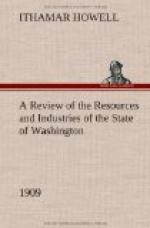[Page 27] Clays of great variety, including fire clays and those suitable for terra cotta, are abundant, and large factories in King county are turning out common and pressed brick of many colors and fine finish, vitrified brick for street paving, terra cotta, stoneware, drain tile, sewer pipe and other kindred products.
At Concrete, a town of 1,200 people in Skagit county, two factories, employing 500 men, are daily turning out 1,400 barrels of Portland cement of fine quality, which is finding ready market in all the large cities.
At Irondale, in Jefferson county, a large plant has been in operation turning out pig iron. It is now in process of being turned into a steel plant and within a few months will be turning out steel bars and pipes for sewer, gas and other purposes. The ores are obtained from Whatcom and Skagit counties, some bog iron in the immediate vicinity and additional ores from Vancouver island. More than a half million dollars has already been invested and this will probably reach a full million when the plant is in complete operation. Although iron ores are present in the state in large quantities, no other serious effort is being made to supply the state with home made pig iron or its products. Here is a vast field awaiting brains and capital. The above represent only a few of the many lines of manufacturing that have been successfully developed in Washington.
TRANSPORTATION.
Commerce and transportation are two affinities, ever seeking each other. They have found on Puget Sound an ideal trysting place. Here the ships of the ocean reach immense placid waters, not duplicated on either side of the continent, and for this reason the railroads have come from the interior to meet them. From foreign ports all over the world ocean carriers are bringing in great loads of merchandise and passengers, and the railroads coming from the Atlantic coast across the entire continent bring like loads of merchandise and human freight, and here they are exchanged. Teas from China and Japan for cotton from Galveston and cotton goods from Massachusetts; [Page 28] rice and silk, hemp, matting, tin, copper and Japanese bric-a-brac are exchanged for grain, flour, fish, lumber, fruit, iron and steel ware, paper, tobacco, etc. Merchandise of all sorts from Asia, the Philippines, South America and Australia is here exchanged for different stuffs raised or made in every part of the American continent and some from Europe. This commerce, however, is in its infancy. The Northern Pacific and Great Northern railways have fattened on it for years. All their rivals have looked on with envious eyes till now a mad rush is on among them all for vantage ground. The Milwaukee, Canadian Pacific and Burlington systems already run their trains here, while the Union Pacific and others are rushing for terminals on Puget Sound tide water. And while thus racing for the great long haul prizes, they are incidentally giving to the state a complete system of transportation in all its parts and for all its multitudinous productions.




